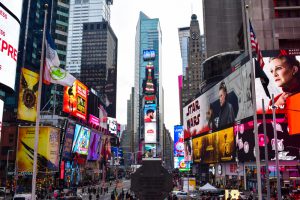By Joel Nelson on June 26, 2019 in Energy News
The Climate Mobilization Act is a package of legislation designed to drastically reduce carbon emissions from New York City’s commercial properties. It covers everything from closing high emitting power plants and installing renewable energy sources to limiting emissions from buildings of over 25,000 square feet. A major component of the proposal, Local Law 97 (formerly Bill 1253), was approved by the city council in April 2019 and focuses on greenhouse gas emissions limits for existing buildings.
We asked Brian Fridkin, a Yardi Client Services Division team leader in Yardi Energy, for an analysis of  LL 97.
LL 97.
Q: How will this bill impact Yardi clients in New York City?
Fridkin: Many clients who own or manage any commercial property of over 25,000 square feet will have to comply with the law’s carbon emission limits starting in 2024. That’s five years away, but they need to act now to meet the deadline. To comply, property owners will have to calculate their building’s carbon limit, which is based on the square footage of their building. They will then have to calculate their current emissions based on the emission coefficients set in the law. To avoid penalties, they will have to make reductions in the next five years that equal the difference between their emissions and limit. What’s more, the emission limits change every five years. The limits for 2030-2034, for example, are about half of those for 2024-2029. That’s good because property owners can ease into the changes, but they must constantly prepare for upcoming limits.
Additionally, there are minimum requirements that a building must meet by 2024, which include adjusting temperature set points for heat and hot water, repairing system leaks, insulating pipes, ensuring steam traps are operating correctly, complying with lighting standards and weatherizing windows. One benefit is that these measures will likely have a relatively quick payback.
Q: Other than the required energy conservation measures in the law, how else can building owners and managers reduce their emissions?
Fridkin: It all begins with tracking usage. Buildings over 25,000 square feet should already be doing this through annual Local Law 84 benchmarking. To comply with this law, you will need to use whole building aggregated data, which includes any tenants that are directly metered by ConEd. You can’t know how much you need to reduce emissions without this data.
Submetering tenant spaces is also extremely valuable because tenant energy consumption can account for more than 80% of the total building load. Tracking consumption helps identify tenants with high consumption and enables outreach to help them to lower their consumption which leads to lower emissions for the property.
The next step is energy efficiency projects such as replacing old equipment and implementing HVAC optimization software. Owners might also want to investigate alternative energy sources such as green roofs, solar panels or wind turbines, which are already a requirement for all new buildings and buildings undergoing major renovations.
Q: What are some other major elements of LL 97?
Fridkin: It allows the purchase of renewable energy credits (RECs) or greenhouse gas offsets to offset emissions. RECs can be purchased to cover 100% of a building’s offset but they must come from New York and be able to feed the capacity of the New York City load zone, conditions that are not accessible for most buildings. It now appears that RECs will be sold bundled in Virtual Power Purchase Agreements (PPAs), long-term (15-year minimum) financial agreements with a renewable energy generation source. PPAs can be complicated agreements that potentially expose clients to financial risk. However, they are extremely beneficial to the environment by supporting renewable energy generation. Greenhouse gas offsets will be a much cheaper option, but the law only allows these to cover 10% of the total emissions limit, so if you are more than 10% over your emission limit you will need to find other ways to reduce.
Q: What are the penalties associated with non-compliance?
Fridkin: They can be steep—$268 per metric ton of carbon, which can add up to millions of dollars per year for some portfolios. The new law does allow some forgiveness for being over your limit if you can prove that you made a strong effort to comply.
Q: How is Yardi Energy helping clients comply with this new law?
Fridkin: Elements of the Yardi Pulse Suite can assist compliance with LL 97 by reducing energy costs and consumption. For example, Yardi Utility Expense Management provides access to all energy cost and consumption data, enabling emission calculations and contributing to benchmarking for ENERGY STAR® reporting. Yardi Pulse Real-Time Metering delivers visibility into real-time demand and consumption that can be used to change how a building operates. Yardi Pulse Active EE optimizes HVAC system performance by making incremental changes to set points every 30 seconds, which reduces consumption while maintaining tenant comfort. Yardi Pulse Fault Detection and Diagnostics helps prevent HVAC system equipment failures before they cost money or tenant comfort. Yardi also offers emission calculations consulting, renewable energy credit and GHG offset purchasing and energy procurement services.
Q: Is there anything else about LL 97 that readers should know?
Fridkin: It’s important to realize how few answers we have about it. The New York City government is just now creating the Office of Building Energy and Emissions Performance to oversee the law’s implementation and answer questions about it. How the low-interest loans for emissions-saving projects will work and if carbon trading will be included are among the issues yet to be determined.


